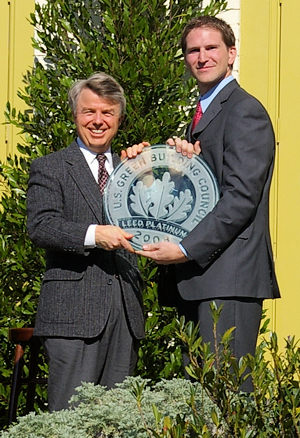Proximity is the First LEED® Platinum Hotel
Named the highest rated “Green” hotel and restaurant in America
Press Release, For more info:
Quaintance-Weaver Restaurants & Hotels
Virginia Phelps, [email protected]
Images and More Media Information
USGBC Case Study for Proximity’s LEED Platinum Certification
October 2008 (Greensboro, NC) — Quaintance-Weaver Restaurants and Hotels announce that Proximity Hotel and Print Works Bistro have been awarded LEED Platinum by the U.S. Green Building Council. LEED is the USGBC’s rating system for designing and constructing the world’s greenest, most energy efficient, and high performing buildings. Opened in late 2007, Proximity Hotel and Print Works Bistro are the first in the hospitality industry to obtain the USGBC’s top level of certification.
Dennis Quaintance , the CEO and CDO (Chief Design Officer) of Quaintance-Weaver, is obviously delighted. “When we started the design process four years ago, I would have never believed that we could use 39% less energy and 33% less water without one iota of compromise in comfort or luxury and with minimal additional construction costs,” says Quaintance. “It just goes to show what a determined team can accomplish if they use common sense and get a little bit of help from the sun.”
His “sun” comment refers to the 100 solar rooftop panels that heat water for the AAA Four Diamond hotel. To illustrate how the hotel and bistro save energy without negatively affecting guest comfort, he asks, “How is it a compromise for a guest to shower with water that is heated by the sun? Or, how is it a compromise for a bistro guest if his or her dishes are washed with solar heated water?”
Quaintance collaborated with his subcontractors on every little detail and personally tested most products. “We tested so many different toilets at home that our children were anxious to see what they called the ‘commode du jour’,” he says. “We finally found one that works wonderfully and uses a third of a gallon less with each flush, and it did not cost one cent more than a conventional toilet.”
The rigorous testing for a variety of water saving products is paying off. The hotel and restaurant is on track to use two million gallons less water during the first year, saving more than $13,000 by spending less than $7,000 in additional construction costs.
“I’ve come to believe that it is an urban legend that employing sustainable practices with new construction is too expensive,” concludes Quaintance. “We are very happy with the results, including the costs and returns, of everything that we did. It’s not easy — but it’s not hard. And it’s definitely worth it.”
Proximity and Print Works did not attain this milestone by just using less

energy and water. They also:
- Recycled 87% of the construction debris (1,535 tons)
- Sourced over 40% of the building materials locally
- Used over 20% recycled content
- Restored 700 feet of an adjacent stream
- Installed the first regenerative drive elevators in North America, generating electricity on the descent for the ascent
- Provided natural lighting (day-lighting) to 97% of the occupied space
- Used elaborate energy recovery systems to provide large amounts of fresh outside air to all guests
- Sourced 90% of the furniture locally
- Commissioned local artists and craftspeople for original art in every guestroom, a cantilevered reception desk, spiral staircases in the lobby, furniture and accessories
- Plus more than 60 other sustainable practices
LEED certification covers energy use, lighting, water and material use as well as incorporating a variety of other sustainable strategies. LEED verifies environmental performance, occupant health and financial return. LEED was established for market leaders to design & construct buildings that protect and save precious resources while also making good economic sense.
“Proximity Hotel is especially to be commended for achieving LEED Platinum. This facility is one that both the community and its guests can be proud of,” said Rick Fedrizzi, President, CEO, Founding Chair, U.S. Green Building Council. “Proximity is a showcase for high-performance, energy-efficient, healthy environment, and an inspiration for others.”
Officials from the USGBC will present the LEED Platinum plaque to the Proximity and Print Works Bistro at a ceremony at the hotel on November 10. On that same day, Proximity will hold its second Sustainable Practices Symposium, a three-hour discussion and tour about the design and building process using the LEED criteria. There is no charge for attendance, but advance registration at www.proximityhotel.com is required.
Built and operated by Quaintance-Weaver Restaurants and Hotels, the Proximity is just a stone’s throw away from its sister businesses, Lucky 32 Kitchen and Wine Bar, Green Valley Grill and the Four Diamond O.Henry Hotel. For more information about Proximity Hotel, call 336-379-8200 or visit www.proximityhotel.com.
